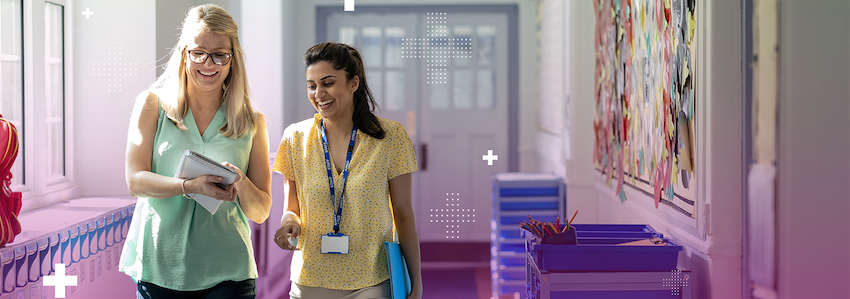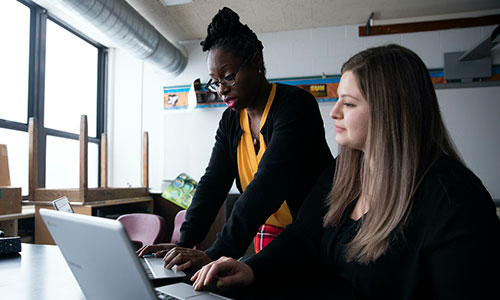
When I was a classroom teacher (and later a school principal), there wasn’t a day that went by when I didn’t wonder if the instructional practices I chose to implement (or encouraged others to use) were likely to have any impact on learning for my students. I sure loved teaching Hatchet, using the latest digital apps to capture students’ focus, and leaning into my favorite co-teaching strategies. But the concern was ever-present: What if it was all a waste of time?
Today, as I support educators in one of the largest school districts in the nation as they face the consequences of staggering interruptions to student learning following COVID-19 school closures, I see the same look of uncertainty on the faces of teachers almost every day. They are working as hard as ever, tying themselves in metaphorical knots to meet the needs of each and every learner in their classroom, all while teaching grade-level standards.
To support teachers during this challenging time, our High Growth for All research project studied what instructional strategies are most effective. The Transformative Ten, as we’re calling these proven strategies, offer a fast track for addressing the perpetual question, “What works?” In this post, I’d like to zero in on strategy #4: Share students and strategies within a grade level.
What does it mean to share students and strategies?
I’ll take a guess that you have heard the term “co-teaching” plenty. My first experience with this concept was as a push-in special education teacher, but neither the math teacher I was working alongside nor I had ever been trained to co-teach. This led to me spending an awful lot of time watching great math instruction instead of teaching alongside my colleague, and I also found myself struggling to find one-on-one time with my students, both for conferences and to check their work.
Was that time impactful? It for sure helped me sharpen my skills for reducing fractions in the kitchen, but my students would have benefitted from a more collaborative approach. They needed—and deserved—more meaningful instruction from me, and they didn’t get it.
Proven to work
Our High Growth for All research shows that when sharing students and strategies within a grade level, we need a far more sophisticated set of co-teaching strategies than the ones I relied on early in my career. Research related to an initiative by Public Impact called Opportunity Culture presents similar results.
The co-teaching strategies should be characterized by strategic student grouping, with equally strategic instruction provided by different teachers of the same grade level or content area. Think “no limits” when it comes to this concept: sharing spaces, flexibly shifting student groups in the moment, collaborative planning times that surface new ideas for leveraging each teacher’s strengths, and more.
When thinking about all of this, I am also reminded of the phrase “collective teacher efficacy.” Does it ring a bell? If you haven’t explored the concept, be sure to visit John Hattie’s site on Visible Learning, where he defines “collective teacher efficacy” as “the collective belief of the school/faculty in their ability to positively affect students” and goes on to explain that it “has been found to be strongly, positively correlated with student achievement.” Hattie’s work is rooted in the research of Rachel Eells.
All of these experts studied how the shared belief of teachers that they can influence student outcomes and increase achievement can exponentially increase the likelihood that they will. Consider the operative word here: “shared.” When collaborating with colleagues on co-teaching strategies (and when implementing any of the Transformative Ten strategies), you will likely multiply your effectiveness with students because you are sharing expertise, passion, and belief in their capacity with your colleagues and throughout your school.
So, how does all this impact happen? Let’s explore three key practices that can help you bring all of this to life:
- Set the stage for collaboration
- Plan and deliver aligned instruction and assessment
- Include collaborative reflection
1. Set the stage for collaboration
Collaborating with your fellow teachers is paramount to successful coteaching. Rather than jumping right to instructional planning, I encourage you to set the stage with some discussions around how you will collaborate. In Habits of Resilient Educators: Strategies for Thriving During Times of Anxiety, Doubt, and Constant Change, my colleague Piper Lee and I highlight the fundamental principle that “all educators possess strengths, and when they come together and collaborate with a common vision, they can accomplish what seems impossible.” To play to your strengths and find your shared vision, consider beginning by having an introductory meeting where you establish the following:
- When and where will you meet
- What roles you will each assume when collaborating (for ideas, check out Doug Fisher and Nancy Frey’s PLC+ resources)
- What meeting norms you will uphold (be sure to use the team norm-building process described in chapter 9 of Habits of Resilient Educators)
- How you will hold yourselves accountable for the work
After that initial meeting, you’ll likely be ready to tackle designing your learning space. Try to remember the merits of remaining flexible. Whatever you decide upon initially can (and perhaps should) change as often as you deem necessary. Build ideas as if you were detectives searching for the best solution: if students respond well to certain seating arrangements or room distributions, for example, take note and repeat. I also encourage you to examine daily and weekly schedules carefully to find opportunities for sharing students and strategies within single instructional periods or finding windows of time at other points during the day.
Remember: when you are working as a team, you’ll find you multiply the most important resource (you, the teacher) and mitigate the constraints of time we all face when working alone.
2. Plan and deliver aligned instruction and assessment
Once you’ve established the structural components for sharing students, it’s time to dive into co-planning for instruction.
Many of us often plan instruction in ways that suit our personal preferences, teaching experience, and goals, so you will likely need to lean on the norms you established in your initial meeting to ensure fruitful collaboration. I also encourage you to let data guide your conversations. If your school tests with MAP® Growth™, leverage the Class Profile report as you make grouping decision and begin thinking about and aligning the instructional resources you will then use to meet your students’ needs.
Does your school take time to collectively examine, or unpack, standards together? If not, now is a good time to start. Check out the practical tips for this process in Habits of Resilient Educators. Piper and I argue that doing so can help you gain a “deeper understanding of the appropriate level of rigor when instructing students.” While it’s easy to assume that your co-teacher is deeply familiar with the standards you’ll be teaching together, remember that “this practice of collectively analyzing standards allows teachers to fix their eyes on the goal of supporting growth and achievement for all students.”
The process of aligning instructional resources and learning activities may take time to coordinate and implement. However, consistency is key for the sake of the students you are striving to support. Does your school or district use common pacing guides, for example? If so, these can be a great starting point. If not, begin with a calendar of when each standard is taught or by establishing the sequence of instructional units. After that, collaboration meetings will be rich with dialogue as you and your co-teacher explore and choose resources, assessments, student groups, and more.
My colleague Mary Resanovich’s advice on supplemental instruction may be particularly handy when you dig into this part of the work.
3. Include collaborative reflection
As your team progresses through the process of designing and delivering aligned instruction, the data you gather will no longer be the outcome of a single teacher’s efforts. Each of you will have influenced every student’s learning outcomes! As a result, your opportunity to examine data together becomes even more rich.
It’s not unusual for co-teaching teams to drift into the comfortable realm of planning logistical elements of team teaching and sharing students. Leverage your initial collaboration norms yet again to uphold a consistent schedule of opportunities to pause and reflect together. Sharing and examining data on a regular basis will inform the crucial decisions you make to maximize your effectiveness as a team. As noted in Habits of Resilient Educators, remember that “by embracing an open mind and constantly endeavoring to uncover new information that empowers our ability to make effective decisions, we move from seeking data as if we were on a witch hunt, to collecting data as if we were on a treasure hunt!”
Slow and steady wins the race
Our High Growth for All study proves that the Transformative Ten strategies can have a big impact on student growth, but it also reminds us that they aren’t meant to be used every single day, or in every single lesson. Becoming comfortable with each of the ten practices will give you an excellent toolbox of proven strategies so you can put that nagging voice asking “What works?” to rest. Allow yourself to explore each strategy, and set reasonable goals for your practice, just as you do for your students.







